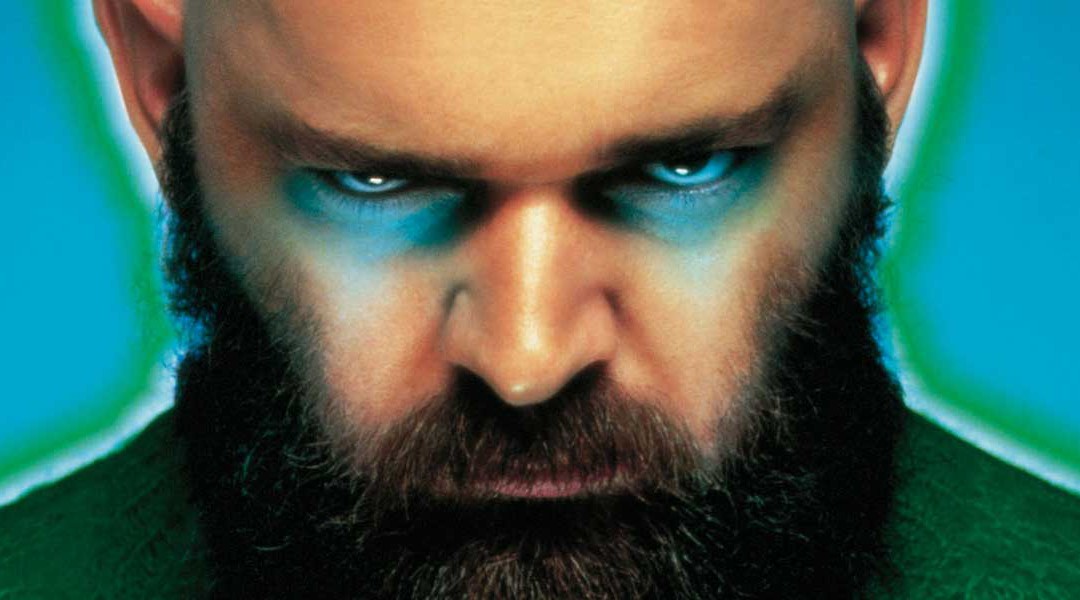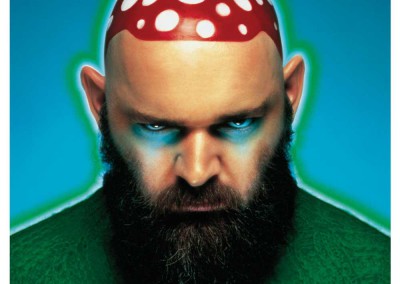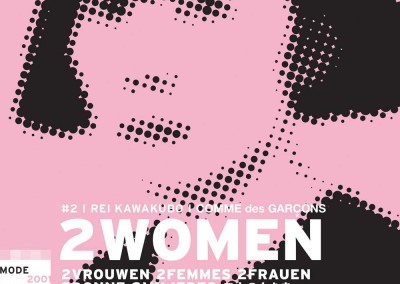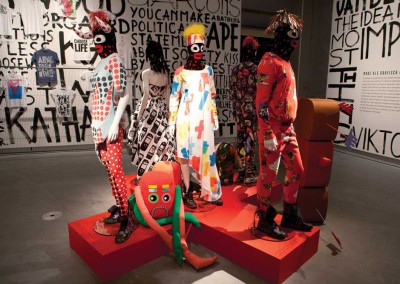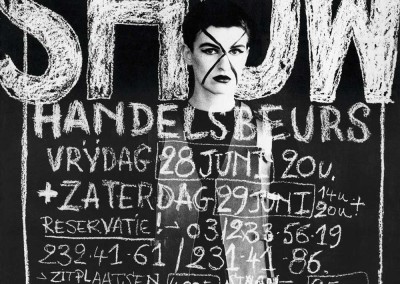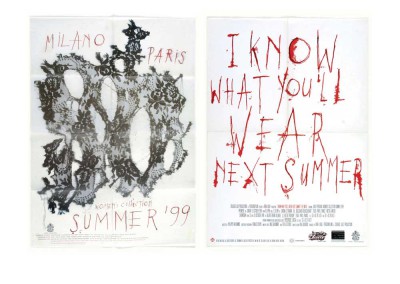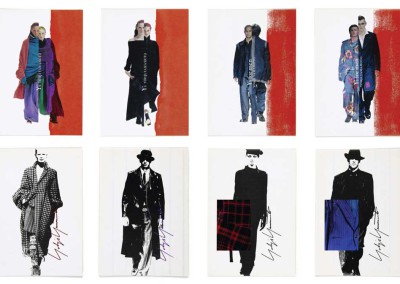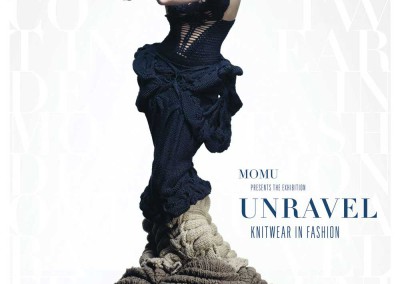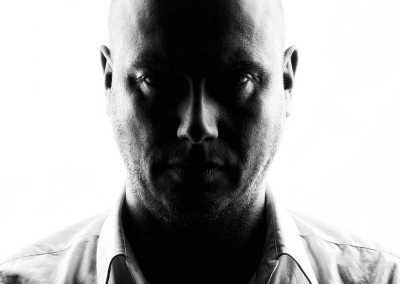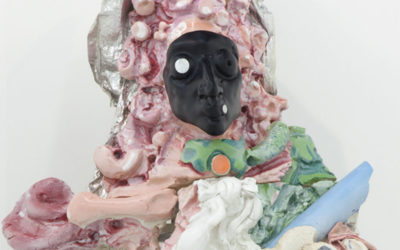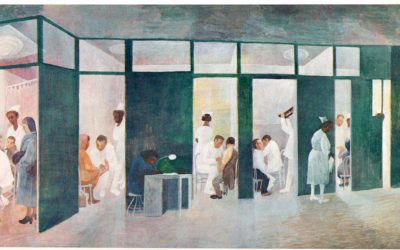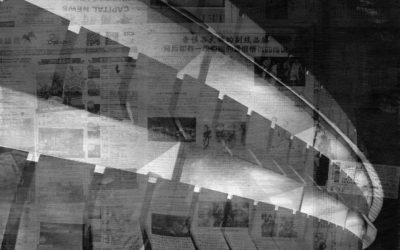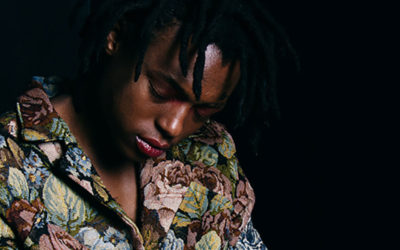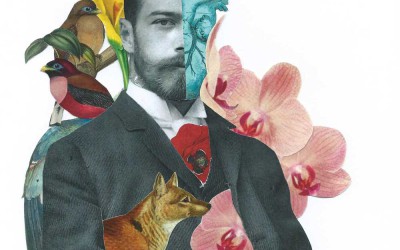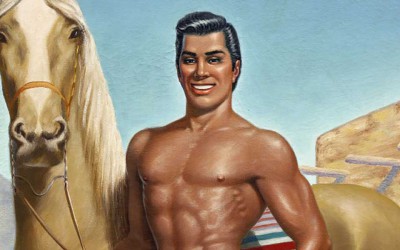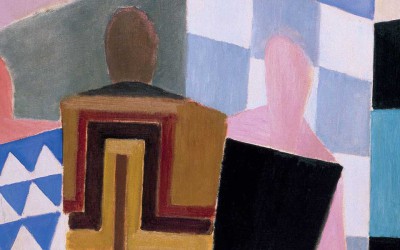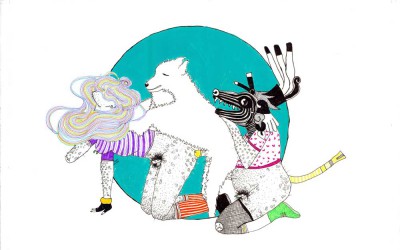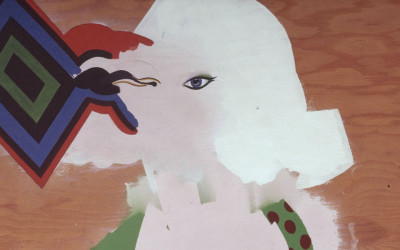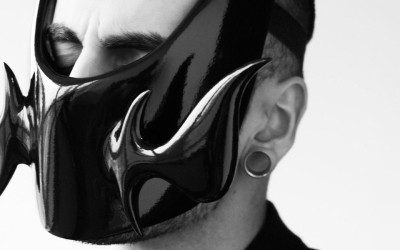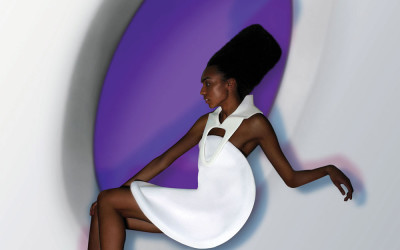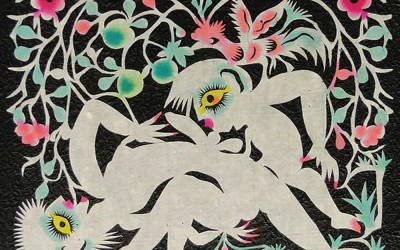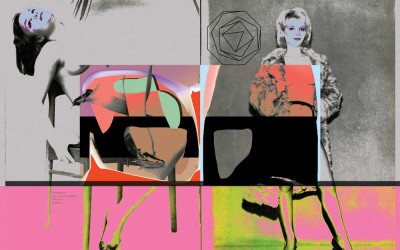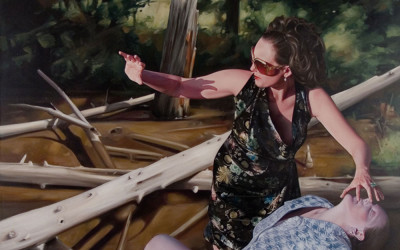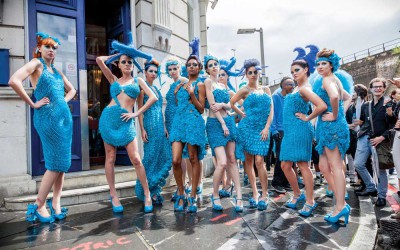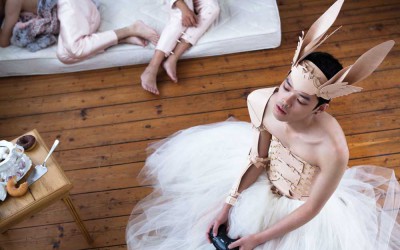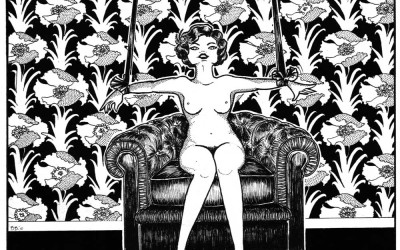Paul Boudens
Text JF. Pierets Artwork Paul Boudens
Originally, Paul Boudens wanted to become a fashion designer when he first set foot in Antwerp. Yet fate decided differently (he flunked his entrance exam) and nowadays he’s one of the most wanted graphic designers working together with the Antwerp Fashion Museum and icons like Walter Van Beirendonck and Haider Ackermann. We catch up with him just as he returns from the Otis College of Art and Design in LA.
I read you were in LA for a “provocative discussion about the creation, reinterpretation, and presentation of fashion”. Did you also have some fun?
Yes, we had a LOT of fun! Last year, Otis asked me to run some workshops with the students, but after sending some e-mails back and forth, I wondered if it wouldn’t be cool to take designer Walter Van Beirendonck, photographer Ronald Stoops and make-up artist Inge Grognard along with me. That way we had the four-leaf clover of Antwerp fashion: a fashion designer, a photographer, a make-up artist, and a graphic designer. Otis instantly loved the idea, and even involved the School of the Art Institute of Chicago (SAIC) so it turned out to be quite a tour.
Antwerp was put on the fashion map in 1988. How did that happen?
Well, if I remember correctly: six graduates of the Fashion Department of the Antwerp Royal Academy staged a group fashion show at London Fashion Week. The British press called them the “Antwerp Six” and turned Flemish fashion into a (inter)national phenomenon.
And fashion has become the fourth largest industry in Antwerp since then.
It’s amazing how much talent we have over here.
You work with Walter Van Beirendonck for over three decades now. Was it a well-considered decision?
Not at all. I rolled in by accident. He asked me to create prints for his T-shirts in 1989. I was in my third year of Graphic Design and Illustration. We’ve been working together ever since. His work explores challenging social issues and ignores conventional trends. It’s great working with this kind of explosive energy.
And quickly your fluorescent colors and exciting invitations attracted the attention of other designers. Isn’t it difficult to work for and with so many different creative people?
In the beginning we had a blast kicking all things sacred and bourgeois. Something that came both out of rebellion as out of inability, I must say: the folly of youth! Or the ignorance and arrogance, of course. (laughs) As time goes by you develop a kind of empathic skill and I discovered that I’m good in translating what a designer wants or likes to see, without losing my own persona.
Nevertheless you describe your work as ‘classic with a schizophrenic twist’.
You have to: that’s how you become when working with so many different people. (laughs)
The punk twist has become partly one of your signatures and your work communicates a strong vision. Is it possible to hold onto your outspoken style in an industry saturated by hype?
I never was a punk, you know. But, most designers create an aesthetic through a certain photographic vocabulary that is already very strong. There’s no reason for me to re-invent that. The image has to stay close to what they are standing for. But they trust me enough to play around with their ‘vocabulary’.
Don’t you ever feel frustrated not having more to do with the principle image?
No. I love working in the shadow of a fashion designer, helping to expand their vision. Once in a while, I venture out into the limelight, but it quickly bores me. I’m perfectly happy where I am and with what I do.
In the meantime, you can add Dries Van Noten, Olivier Theyskens, Comme des Garçons, Yohji Yamamoto, Wim Neels, Jurgi Persoons, A.F. Vandevorst, Haider Ackermann, The Antwerp Fashion Academy, Het Zuidelijk Toneel and MoMu, the Fashion Museum of the Province of Antwerp, and many others to your palmarès. What are the things you are most proud of?
I consider every thing I design as a sort of ‘baby’, you know. But, two things are very dear to me. First, there’s my monograph Paul Boudens Works Volume I, which was published in 2003, and second there’s my solo exhibition at The Wapping Project in London in 2010 called ‘Trust Me (I Know What I’m Doing)’. How’s that for an ego boost! (laughs)
In 2001, you were responsible for the art direction of ‘Fashion 2001 Landed’, the ambitious fashion city project in Antwerp with Walter Van Beirendonck and Gerdi Esch. Didn’t you become art director and graphic designer of A Magazine during this project?
You are totally right, my dear. (laughs) We wanted A Magazine to be a fashion magazine that explores the universe of a chosen fashion designer in each issue. We invited a guest curator – an international fashion designer, group or house – to develop innovative, personalized content to express their aesthetic and cultural values. Each issue celebrated the designer’s ethos: their friends, their passion, their stories, emotions, fascinations, spontaneity and authenticity. Back then, we made issues with, among others, Bernhard Willhelm, Hussein Chalayan and Olivier Theyskens, and more recently Maison Martin Margiela, Yohji Yamamoto, Haider Ackermann and Riccardo Tisci from Givenchy. The magazine was always a wonderful race against time. I got the material a little ahead of time, so I could do some preliminary lay-outs for when the designer came to Antwerp, we could work like crazy to do the whole magazine in three or four days. Sadly, I had to say goodbye to the magazine: let’s cite musical differences. (laughs)
‘I started off making cassette covers and cards for friends with Mecanorma letters in a time when colour photocopies were still a novelty. Yes, I’m a dinosaur now.’
Does fashion still make you happy?
You know, fashion itself doesn’t interest me. (laughs) But it’s a fun sector to work in. However, society has changed tremendously in the last ten years and fashion became a really serious business. Everything has to be profitable so things are less intuitive, spontaneous and dangerous. Nevertheless, that’s the way it is and I like the fast pace of fashion. I can’t remember what a holiday feels like because I’m always at work and the fashion show invitations are always lurking around the corner.
Next to fashion show invitations you’re also designing books, catalogs, posters. You obviously love your work.
I just love to create stuff. Maybe it’s because I’m easily bored. I always say: ‘the nicest job is always the next one’.
Do you have other ambitions?
Not really, like I said before: I am where I should be, doing what I should do. I once said that finding the right typeface is like falling in love — I guess that illustrates how I feel about my work.
Were you the class swat or the rebel?
As a teenager I was a total wuss: if I would meet myself now I would kick myself and shout ‘MAN UP!’. However, studying graphic design, I had a lot of fun. Mind you, I flunked my entrance exam to the Antwerp Fashion Academy in the mid-80’s and on a comfortable budget from my parents; I tried some other things like Press and Communication and Translation. Nevertheless, the moment I really had to make an effort and discovered Graphic Design, I knew where my heart was and it went rather smoothly.
You started off in the ‘80’s so I guess the tools to work with were quite different from now?
I started off making cassette covers and cards for friends with Mecanorma letters in a time when colour photocopies were still a novelty. Yes, I’m a dinosaur now. (laughs) I guess you can say the possibilities were different, yet not per definition worse; on the contrary: there was a lot more freedom!
Your work shows taped edges and paint splatters on wallpaper or cotton amongst other materials. The result is both rough and sharp, somewhat twisted and leaving a strange impression. Is that where your handywork comes in?
You know, I started analog then went digital — there was no other choice. But I like that combination: design or art is simply not done just on a computer. When you work with tape, paper and scissors, your mind works differently than when behind a screen. Anyway, I always want to give my work a human touch.
What’s your main philosophy when it comes to your work?
I don’t like designs with a shelf life of one day only. How ironic this might seem while working mainly in fashion, I want my work to be timeless, which is actually impossible. However, my work ages quite well, I think — there’s some good genes in it. (laughs)
And does it always work?
Not always, of course. Most of the time the right image pops up in my head and I try to recreate that. If nothing appears, I’m in trouble, but it happens rarely… (laughs) If it takes a little longer, there’s always my gut feeling, which makes me avoid hypes and go for the long run.
Tell me your future dream.
Yuk, what a difficult question! Let’s say ‘publishing the second volume of my monograph’, maybe? It’s Bald Ambition I guess: look at my head! (laughs)
Related articles
Nadia Naveau
From the moment I started at the academy I noticed that sculpting was very demanding on both a physical and a psychological level. This has never diminished. I very much like what I do, but a large percentage of my practice involves…..
Bernard Perlin
In One-Man Show, Michael Schreiber chronicles the storied life, illustrious friends and lovers, and astounding adventures of Bernard Perlin through no-holds-barred interviews with the artist, candid excerpts from Perlin’s unpublished…..
Faryda Moumouh
Since I was young I was already drawing, watching, registering details from the things I saw. It was an urge and I had the feeling I was chosen by a visual language, which I pursued. I went to art school when I was 14 and it made me discover…..
Lebogang Mokgoko
I think I represent a new wave of creators. We’ve been exposed to the internet, grew up listening to Kanye West, so obviously we’re going to adapt that whole theory of multidiscipline as opposed to doing only one thing. On paper I studied design…..
Agustin Martinez
“Dancers don’t always know what they are doing”, “Revelations from a sailor from Rotterdam” and “The past is alert and ready” are just a few of the many intriguing titles of the work by collagist Agustin Martinez; a fellow countryman of Pablo Picasso…..
George Quaintance
George Quaintance was an artist ahead of his time, a man who forged several successful careers, yet never enjoyed mainstream fame. Had he been born a few decades later, we might know him today as a multi-tasking celebrity stylist, as a coach…..
Sonia Delaunay
Sonia Delaunay (1885–1979) was a key figure in the Parisian avant-garde, whose vivid and colorful work spanned painting, fashion and design. Tate Modern presents the first UK retrospective to assess the breadth of her vibrant artistic…..
Bernhard Willhelm
The Museum of Contemporary Art, Los Angeles presents the first American museum exhibition of the work of fashion designers Bernhard Willhelm and Jutta Kraus. Bernhard Willhelm 3000: When Fashion Shows The Danger Then Fashion Is The Danger…..
Rurru Mipanochia
Rurru Mipanochia is a 25 year old, Mexican illustrator. Her drawings represent ancient pre-Hispanic sexual deities, transvestites and transseksuals, in order to promote dissident sexualities and to create a visual questioning about beauty…..
Allen Jones
Three women, wearing black leather fetish gear, produced by the same company that supplied Diana Rigg’s costumes in The Avengers. One of them is on all fours and the glass top on her back awaits your drink. The second one wears thigh high…..
Rein Vollenga
You can call it ‘wearable sculpture’, if you really want to give it a name. Those who would like to look outside the box a bit might see an attractive work of art, dark yet extremely seductive. Whether he is a sculptor or a milliner, Rein Vollenga is a…..
Peter Popps
Highly experienced shoe professional, Peter Popps, recently released his own amazing line of shoes. As we speak, Lady Gaga is wearing Peter’s CUBE creation during the shoot for ‘ARTPOP’ by Inez Van Lamsweerde and Vinoodh Matadin. An interview…..
Xiyadie
Paper-cuts originated in Eastern Han Dynasty China (AD 25-220) and are hung on windows or doors for good luck. But instead of the usual decorative flowers and birds, Xiyadie, whose pseudonym means ‘Siberian Butterfly’, portrays graphic and…..
AMVK
Anne-Mie Van Kerckhoven is known for creating a diverse body of work in painting, sculpture and installation that has made her among the most important Belgian artists of her generation. She embraces a complex array of subjects, including alchemy,…..
Jennifer Nehrbass
Someone once wrote that she was dismantling the roles and stereotypes of beauty and femininity, examining the psychology that leads women to go to extremes to maintain beauty and style. Needless to say that our brain got tickled so we…..
Pierre Garroudi
His intricate designs merge the lines between art & fashion and have been worn by some of the world’s biggest style icons from Naomi Campbell to Kate Moss, Scarlet Johansson and Sarah Jessica Parker. He walks the streets of London with his…..
Niels Peeraer
“I’m confused, I’m sitting here on the sofa, the heart my boyfriend drew on the mirror is still there, my heart in a rice cooker. I think I’ll marry him again at lunch. My cat is sleeping but it’s already been 4 days. Well, I have to go to the supermarket…..
Betty Black
Betty Black started off as a name, just a made up name. An alter-ego that I created for myself in an attempt to perfect one distinctive style of work, rather than end up with a variety of mediocre crap, after having just coasted through a pointless…..
